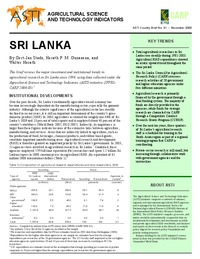Authors:
Stads, Gert-Jan; Gunasena, Herath P. M.; Herath, Walter
Year:
2005
Publisher
International Food Policy Research Institute (IFPRI); and Sri Lanka Council for Agricultural Research Policy (CARP)
Back to:
During 1981-2003, the number of agricultural researchers in Sri Lanka increased steadily. Agricultural R&D spending also rose throughout this period, albeit more erratically. In 2003, total expenditures amounted to $60 million (in 2000 constant prices). Research agencies focusing on export plantation crops reported remarkable increases in their total spending levels over the previous two decades. Combined spending totals at the eight agencies under MALLI, however, remained relatively unchanged during the same period.
With the exception of the plantation crop research institutes, which receive sizable shares of their total budget through cess proceeds, Sri Lanka’s government R&D agencies are primarily financed by the national government through a dual funding system. The government directly provides operational and capital funds, and channels funds for strategic research via CARP’s CCRGP, a competitive funding mechanism. The introduction of CCRGP is a positive development and one that has already promoted collaboration between the various agencies in the country’s national agricultural research system. It has also accelerated private sector involvement in the agricultural R&D field, a phenomenon that had been extremely limited thus far. Total CCRGP funds have risen rapidly in recent years and are expected to rise further in the future as a result of the Sri Lankan government’s acknowledgement of the importance of R&D for agricultural productivity growth. Nonetheless, at present, CCRGP funds still represent a very small percentage of total agricultural R&D financing and the program can only run efficiently in the future if a wellfunctioning incentive system is established that recognizes research outputs and forces more researchers to apply for such funds.
These changes were accompanied by the establishment in 2002 of a training program for research staff. Memoranda of understanding with the principal agricultural research agencies in other South Asian countries allow Sri Lankan researchers to improve their research capacity in contexts relevant to the Sri Lankan situation. In the next ten years, three quarters of Sri Lankan research staff are scheduled for training as part of this program. This will most certainly have a positive effect on the quality of future research outputs in the country.

